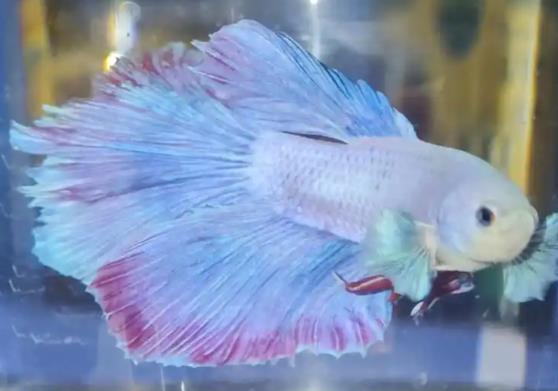Causes of Popeye Disease in Betta Fish
Deteriorated Water Quality

Elevated levels of ammonia, nitrite, or drastic fluctuations in pH can irritate the mucous membrane of bettas’ eyes, leading to edema (swelling) or congestion of eye tissues. In severe cases, this irritation results in exophthalmos (protruding eyes).
Common contributing factors include:
Infrequent water changes over an extended period
Malfunctioning filtration systems
Overstocking (high tank population density)
Bacterial Infections
Pathogenic bacteria such as Flavobacterium columnare and Aeromonas hydrophila can trigger eye inflammation. Symptoms typically include cloudy eyes, eye congestion, and in severe cases, eye ulceration.
This type of infection is often accompanied by other systemic signs, such as bleeding on other parts of the body or abdominal dropsy (fluid buildup in the abdomen).
Parasitic Infections
Parasites like Diplostomum (eye flukes) and ciliates may invade bettas’ eye tissues or optic nerves. This invasion causes mechanical pressure on the eyes or inflammatory reactions.
In the early stages, popeye may affect only one eye (unilateral).
In advanced stages, it often progresses to both eyes (bilateral), accompanied by granular “lens-like” deposits or ring-shaped congestion around the eyes.
Other Causes
Physical injury: Scratches from sharp tank decorations (e.g., rough rocks, jagged driftwood).
Nutritional deficiencies: Insufficient intake of vitamins A or C.
Internal diseases: Disorders of the liver or kidneys, which can disrupt fluid balance and lead to eye swelling.
Treatment and Care Protocols
Emergency Handling
Isolate the sick betta: Transfer the affected fish to a separate treatment tank (5–10 liters in volume) to prevent cross-contamination with other tank inhabitants.
Water quality management:
Replace 1/3 of the water daily with aged, temperature-matched water (to avoid shocking the fish).
Maintain a stable pH level of 6.5–7.5 and a water temperature of 28–30°C (optimal for betta recovery).
Medication Therapy
Infection TypeTreatment Method
Bacterial InfectionAdd 1–2 mg of nitrofurazone (yellow powder) or oxytetracycline per liter of water. Administer a 30-minute bath 1–2 times daily for 3–5 consecutive days.
Parasitic Infection- Bath the fish in water containing 4–6 mg of metronidazole per liter for 2 hours.
- For parasite sources like snails (hosts for some parasites), completely empty and clean the tank to eliminate snails and root out the infection.
Adjunctive TherapyAdd 1–3 grams of non-iodized coarse salt per liter of water to reduce eye swelling. (Note: Do not use table salt with iodine, as it is toxic to fish.)
Environmental Optimization
Remove all sharp or rough decorations from the tank to prevent further injury.
Reduce tank population density if overstocked.
Withhold feeding for 1–2 days during treatment (to reduce waste production and ease stress on the fish’s digestive system).
If a parasitic infection is suspected: Thoroughly clean the tank and disinfect it (e.g., using a food-safe disinfectant like Defu Disinfectant) to eliminate residual parasites or eggs.
Preventive Measures
Regular water monitoring:
Replace 1/3 of the tank water weekly.
Test water parameters (ammonia, nitrite, pH) regularly to ensure they stay within safe ranges.
Scientific feeding:
Provide a diversified diet, including live food (e.g., bloodworms) alongside high-quality betta pellets fortified with vitamin premixes.
Quarantine new additions:
Disinfect and quarantine any new fish or aquatic plants in a separate tank for 2–4 weeks before introducing them to the main tank. This prevents the introduction of pathogens.
Prognosis Assessment
Mild infections: The white film on the eyes typically fades within 1 week, and protruding eyes gradually return to their normal position.
Severe infections: If no improvement is seen after 3–5 days of treatment, re-evaluate the underlying cause (e.g., rule out misdiagnosis) or consult a professional aquatic veterinarian for further guidance.
